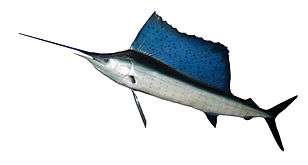Black marlin
| Black marlin | |
|---|---|
 | |
| Scientific classification | |
| Kingdom: | Animalia |
| Phylum: | Chordata |
| Class: | Actinopterygii |
| Order: | Perciformes |
| Family: | Istiophoridae |
| Genus: | Istiompax Whitley, 1931 |
| Species: | I. indica |
| Binomial name | |
| Istiompax indica (G. Cuvier, 1832) | |
| Synonyms | |
| |
The black marlin (Istiompax indica) is a species of marlin found in tropical and subtropical areas of the Indian and Pacific Oceans.[2] With a maximum published length of 4.65 m (15.3 ft) and weight of 750 kg (1,650 lb),[2] it is one of the largest marlins and also one of the largest bony fish. This marlin is one of the fastest fish, with speeds of up to 129 km/h (80 mph) as estimated from the speed that hooked marlins are able to unwind fishing line.[3] Black marlin are fished commercially and are also a highly prized game fish.
Description
Compared to striped or white marlins and sailfish, black marlins are more solid than their blue counterparts. They have a shorter bill and a rounder and lower dorsal fin. Black marlin may be distinguished from all other marlin species by their rigid pectoral fins, which, especially from a weight of around 150 lb (75 kg) or so, are unable to be pressed flat against their sides.
Diet
Diet mostly consists of various fishes and cephalopods.
Recreational fishing
Many people see the black marlin as the premier game fish for sport fisherman. Because of their size and physique, these marlins are popularly fished. Research off the coast of Australia suggests the large creature is much easier to catch around the full moon and the week afterwards due to its prey moving to the surface layers, which in turn forces the marlin to hunt in a wider area.
Distribution
In addition to the Australian coast, black marlin can also be found throughout the tropical Indo-Pacific waters. They can also be found from Southern California to the Gulf of California to Chile, including the coast of all oceanic islands in between. They tend to stay in warmer waters and hunt the surface. In addition to warmer waters, they also are found close to land masses as opposed to wide-open water.
References
- ↑ Collette, B.; Acero, A.; Canales Ramirez, C.; Carpenter, K.E.; Di Natale, A.; Fox, W.; Miyabe, N.; Montano Cruz, R.; Nelson, R.; Schaefer, K.; et al. (2011). "Istiompax indica". IUCN Red List of Threatened Species. Version 2011.2. International Union for Conservation of Nature. Retrieved 15 December 2011.
- 1 2 Froese, Rainer and Pauly, Daniel, eds. (2013). "Istiompax indica" in FishBase. April 2013 version.
- ↑ BBC Worldwide (27-05-2008). Black marlin - the fastest fish on the planet. Ultimate Killers - BBC wildlife.
- "Makaira indica". Integrated Taxonomic Information System. Retrieved 19 March 2006.
- Froese, Rainer, and Daniel Pauly, eds. (2013). Species of Istiompax in FishBase. April 2013 version.
- Tony Ayling & Geoffrey Cox, Collins Guide to the Sea Fishes of New Zealand, (William Collins Publishers Ltd., Auckland, New Zealand 1982) ISBN 0-00-216987-8

